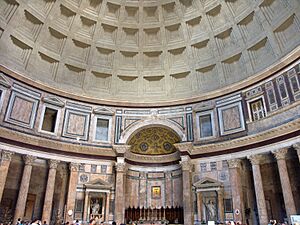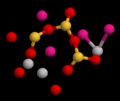Roman concrete facts for kids
Roman concrete, also known as opus caementicium, was a special building material used in ancient Rome. Just like the concrete we use today, Roman concrete was made from a special kind of cement that hardened when mixed with water. This cement was then combined with other materials like small stones or sand.
Many buildings and structures from ancient Rome are still standing today. These include bridges, water storage tanks, and aqueducts (structures that carried water). This shows how strong and useful Roman concrete was! Sometimes, they made it even stronger by adding a special volcanic ash called pozzolanic ash. This ash helped stop cracks from spreading. Scientists recently found that Roman concrete could even fix its own cracks! It had tiny pieces of lime that reacted with water to create new crystals, sealing up any damage.
Romans started using this concrete a lot around 150 BC. Some experts think it might have been invented even earlier.
Roman concrete was often used with other materials for support. The inside walls were then decorated with plaster, paintings, or colorful marble. New ideas in using this concrete led to amazing buildings with complex shapes. The most famous example is the dome of the Pantheon. It's the biggest and oldest concrete dome in the world that doesn't have any extra support inside!
Roman concrete was a bit different from modern concrete. It often had larger pieces mixed in, so it was laid down rather than poured. Also, like all concrete that hardens with water, Roman concrete could set underwater. This was super helpful for building bridges and structures near rivers or the sea.
Contents
What Was Roman Concrete Made Of?
Roman concrete, like all concrete, had two main parts: a mix of materials called an aggregate and a special glue called hydraulic mortar. This mortar was mixed with water and hardened over time. The aggregate could be different things, like pieces of rock, broken ceramic tiles, or even bricks from old buildings. In Rome, they often used a soft volcanic rock called tuff because it was easy to find.
For the glue part, they used gypsum and quicklime. They especially liked volcanic dusts, known as pozzolana, if they could get them. Pozzolana made the concrete much better at resisting salty seawater than today's concrete. This special mortar had a lot of alumina and silica in it.
Recent studies in 2023 found something amazing about those small lime pieces in Roman concrete. People used to think they were a sign of poor mixing. But it turns out, these lime pieces react with any water that seeps into cracks. This reaction creates new calcium, which then forms new calcium carbonate crystals. These crystals actually seal up the cracks! These lime pieces were likely made using a "hot-mixing" method with quicklime, which made them brittle. This meant cracks would go through them, helping the concrete fix itself.
Roman concrete was like a strong ceramic material. It was easy to shape when wet, and then it became very hard. The way it hardened was different from older types of mortar, which just dried. Roman concrete hardened through chemical reactions with water. Once it was hard, it didn't bend much, but it could still handle some pulling forces.
The way pozzolanic cements hardened was similar to how modern Portland cement hardens. The Roman pozzolana cements had a lot of silica, much like modern cements that have things like blast furnace slag, fly ash, or silica fume added to them.
Scientists now understand why Roman "marine" concrete (used in the sea) was so strong and lasted so long. When seawater mixed with the volcanic ash and quicklime, it created a rare crystal called tobermorite. This crystal helps the concrete resist breaking. As seawater slowly moved into tiny cracks, it reacted with a mineral called phillipsite (found in the volcanic rock) and made these special tobermorite crystals. This makes Roman marine concrete possibly "the most durable building material in human history." In contrast, modern concrete often breaks down in saltwater within a few decades.
Another type of Roman concrete, found at the Tomb of Caecilia Metella, had more potassium. This caused changes that made the concrete even stronger and helped it perform better.
How Roman Concrete Handled Earthquakes
The Italian peninsula where Rome is located often has earthquakes. To deal with this, Roman builders made their concrete walls and domes with breaks and different sections inside. This meant that when the ground shook, parts of the building could move slightly. This flexibility helped the whole structure stay strong. It's why, even though many Roman buildings got cracks from various causes, they are still standing today!
Another clever trick to make concrete stronger was to change its weight in domes. For example, in the Pantheon, the concrete in the upper part of the dome used light materials like tuff and pumice. This made the concrete lighter, about 1,350 kilograms per cubic metre (84 lb/cu ft). But the foundation of the building used a much heavier stone called travertine, making the concrete there about 2,200 kilograms per cubic metre (140 lb/cu ft). This made the dome lighter at the top and heavier at the bottom, making it very stable.
Modern Discoveries and Uses
Since 2010, scientists have been studying Roman concrete more closely. Its amazing strength, long life, and smaller impact on the environment have caught the eye of both the media and building companies. Because of this, some companies and cities in North America are starting to look into using Roman-style concrete. Instead of volcanic ash, they are using coal fly ash, which has similar properties.
Supporters say that concrete made with fly ash could cost up to 60% less because it needs less cement. It's also better for the environment because it's made at lower temperatures and lasts much longer. We have examples of Roman concrete that are 2000 years old and have been in harsh ocean environments, yet they show very little wear!
In 2013, the University of California Berkeley explained for the first time how a super-stable compound called calcium-aluminium-silicate-hydrate makes the material so strong. When Roman concrete was made, it released less carbon dioxide into the air compared to modern concrete production. It's also true that Roman buildings had thicker walls than modern ones. However, Roman concrete continued to get stronger for many decades after the buildings were finished.
See also
- Energetically modified cement (EMC)
- Geopolymer
- Roman brick
- Roman cement
- Pozzolanic activity
- Tobermorite
Images for kids





